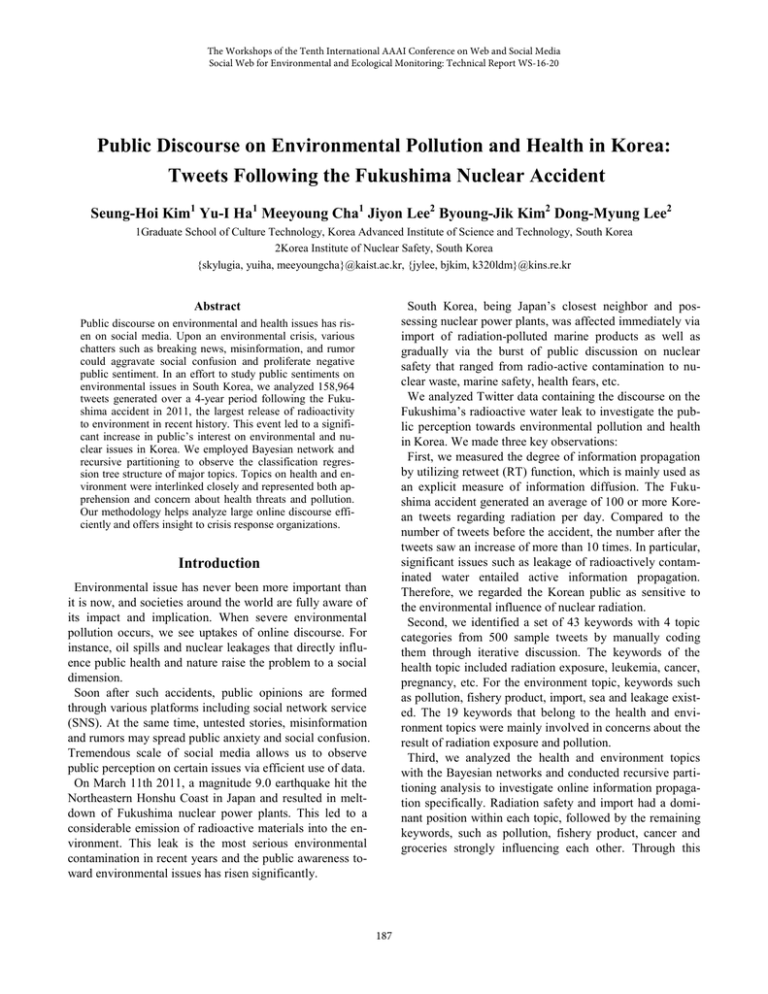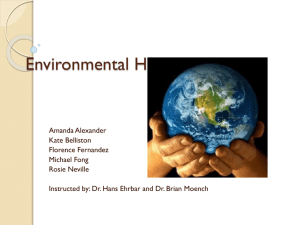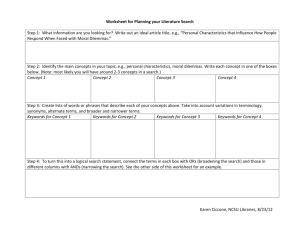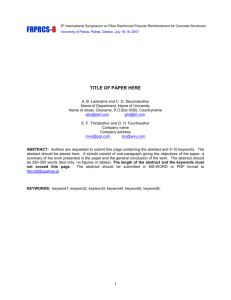Public Discourse on Environmental Pollution and Health in Korea:
advertisement

The Workshops of the Tenth International AAAI Conference on Web and Social Media
Social Web for Environmental and Ecological Monitoring: Technical Report WS-16-20
Public Discourse on Environmental Pollution and Health in Korea:
Tweets Following the Fukushima Nuclear Accident
Seung-Hoi Kim1 Yu-I Ha1 Meeyoung Cha1 Jiyon Lee2 Byoung-Jik Kim2 Dong-Myung Lee2͑ ͑
1Graduate School of Culture Technology, Korea Advanced Institute of Science and Technology, South Korea
2Korea Institute of Nuclear Safety, South Korea
{skylugia, yuiha, meeyoungcha}@kaist.ac.kr, {jylee, bjkim, k320ldm}@kins.re.kr
South Korea, being Japan’s closest neighbor and possessing nuclear power plants, was affected immediately via
import of radiation-polluted marine products as well as
gradually via the burst of public discussion on nuclear
safety that ranged from radio-active contamination to nuclear waste, marine safety, health fears, etc.
We analyzed Twitter data containing the discourse on the
Fukushima’s radioactive water leak to investigate the public perception towards environmental pollution and health
in Korea. We made three key observations:
First, we measured the degree of information propagation
by utilizing retweet (RT) function, which is mainly used as
an explicit measure of information diffusion. The Fukushima accident generated an average of 100 or more Korean tweets regarding radiation per day. Compared to the
number of tweets before the accident, the number after the
tweets saw an increase of more than 10 times. In particular,
significant issues such as leakage of radioactively contaminated water entailed active information propagation.
Therefore, we regarded the Korean public as sensitive to
the environmental influence of nuclear radiation.
Second, we identified a set of 43 keywords with 4 topic
categories from 500 sample tweets by manually coding
them through iterative discussion. The keywords of the
health topic included radiation exposure, leukemia, cancer,
pregnancy, etc. For the environment topic, keywords such
as pollution, fishery product, import, sea and leakage existed. The 19 keywords that belong to the health and environment topics were mainly involved in concerns about the
result of radiation exposure and pollution.
Third, we analyzed the health and environment topics
with the Bayesian networks and conducted recursive partitioning analysis to investigate online information propagation specifically. Radiation safety and import had a dominant position within each topic, followed by the remaining
keywords, such as pollution, fishery product, cancer and
groceries strongly influencing each other. Through this
Abstract
Public discourse on environmental and health issues has risen on social media. Upon an environmental crisis, various
chatters such as breaking news, misinformation, and rumor
could aggravate social confusion and proliferate negative
public sentiment. In an effort to study public sentiments on
environmental issues in South Korea, we analyzed 158,964
tweets generated over a 4-year period following the Fukushima accident in 2011, the largest release of radioactivity
to environment in recent history. This event led to a significant increase in public’s interest on environmental and nuclear issues in Korea. We employed Bayesian network and
recursive partitioning to observe the classification regression tree structure of major topics. Topics on health and environment were interlinked closely and represented both apprehension and concern about health threats and pollution.
Our methodology helps analyze large online discourse efficiently and offers insight to crisis response organizations.
Introduction
Environmental issue has never been more important than
it is now, and societies around the world are fully aware of
its impact and implication. When severe environmental
pollution occurs, we see uptakes of online discourse. For
instance, oil spills and nuclear leakages that directly influence public health and nature raise the problem to a social
dimension.
Soon after such accidents, public opinions are formed
through various platforms including social network service
(SNS). At the same time, untested stories, misinformation
and rumors may spread public anxiety and social confusion.
Tremendous scale of social media allows us to observe
public perception on certain issues via efficient use of data.
On March 11th 2011, a magnitude 9.0 earthquake hit the
Northeastern Honshu Coast in Japan and resulted in meltdown of Fukushima nuclear power plants. This led to a
considerable emission of radioactive materials into the environment. This leak is the most serious environmental
contamination in recent years and the public awareness toward environmental issues has risen significantly.
187
concept, the authors categorized and organized keywords
into hierarchical orders, as described in Table 1.
process, we understood local distribution of the keywords
and created a specified decision rule.
Our methodology helps to identify main keywords, allows
make intuitive and subdivided distribution model about
online discourse. Social media facilitate communication
and help form social capitals prior to occurrence of such
catastrophic situation (Kaigo, 2012). Therefore, our finding can be utilized for providing information strategies to
help the public understand about emergency situation and
offer insight to crisis response organization.
Table 1 Classification of 43 keywords on nuclear issues
Methodology
Topic
Keywords
Location
(18.6%)
Health
(20.9%)
Environment
(23.3%)
Domestic, Republic of Korea, Our country, Korean
Peninsula, Korea, Tokyo, Fukushima, Japan
Thyroid, Health, Leukemia, Maternity, Cancer,
Pregnancy, Radiation Exposure, groceries, Food
Leakage, Sea, Import, Fishery products, Pollution,
Environment, Agricultural products, Leakage,
Travel, Forest resources
Cesium, Iodine, Operation, Alert, Worn out, Security, Black out, Corruption, Accident, Stability,
Media control, Risk management, Risk, Concealment, Doubt, Fact
Nuclear
Power
(37.2%)
We gathered 158,964 Korean tweets from January 1,
2011, two months prior to the Fukushima accident, until
December 14, 2014, by searching for streams containing
the following keywords: Radioactive, Radiation, Nuclear
Power, as well as their variations. For each tweet, we know
the time of posting, username, number of retweets, favorites, and comments.
The data show a critical change in terms of total number
of tweets and retweets, where the average number of daily
tweets mentioning nuclear topics increased by more than
10 times from 10 tweets per day before the Fukushima accident to over 100 tweets per day after the event. Prior to
the crisis, most mentions were not related to any health or
environmental threats (e.g., department of radiology).
The frequency of tweets over the 4-year period captures
well the major events such as the Tohoku Earthquake, and
apology by the Japanese government for the illegal discharge of radioactively contaminated water and entails an
active level of information propagation and public attention. This implies that the Korean public became sensitive
to potential threat of a nuclear accident and actively propagated information on issues related to nuclear power.
Keywords in the location category were mainly associated with comparison between Japan and Korea. We deduced that Koreans were concerned about the harmful consequences of the nuclear accident from Japan. Health category was divided into two main keywords: food and human body. Keywords such as thyroid, leukemia, and cancer seem to have resulted from an anxiety about exposure
to radiation and its effect on health. This tendency also
emerged in the environment category as concerns about the
contamination of agro-fishery products, trading of contaminated goods, and safety of traveling to Japan.
Hence, which keywords had the highest frequencies and
how to relate them to each other are the most pressing
tasks for understanding online discourse related to environmental pollution and the proper measures to take for
prevention.
Bayesian Network and Recursive Partitioning
Analysis on Health and Environment Keyword
Since keywords in health and environment topics directly
affect safety of human body and environment, the corresponding topics received much more public attention than
the other topics, on location and nuclear power.
We now observe the mentioned rate classified by keywords via Bayesian networks. In this graphical model,
nodes represent random variables and arrows represent the
probabilistic dependencies among nodes that are identified
by recursive partitioning analysis, a statistical method for
multivariable analysis on each topic. This model helps us
understand a sparse set of keywords of direct dependencies.
Result
Perception towards the Nuclear Issues
High-quality information and well-organized risk strategies that have been prepared for potentially affected communities increase the level of preparedness, resulting in efficacious disaster management (Svendsen, 2013). Searching for topics of discourse on environmental and nuclear
issues should be a sound basis for establishing effective
countermeasures upon crisis.
To identify major keywords from data, a random sample
of 500 tweets were manually coded, where all of the authors read the online discourse and coded them based on
inductive arguments. The obtained keywords were validated through iterative discussion until an agreement was
reached among the coders. In order to build a higher-level
Discourse on Health Topics
Figure 1 shows the pie-chart encompassing each keyword
in the health topic. Radiation Exposure is the most frequently mentioned keyword, followed by cancer, groceries,
health, food, thyroid, and leukemia in order of frequency.
188
Discourse on Environmental Topics
Figure 3 shows that pollution is the most frequently mentioned keyword in the environmental topic. Twitter users
exhibited worries about pollution with their opinions (e.g.
“radiation-contaminated scrap metal imported from Japan
is okay”) and unconfirmed information (e.g. “The Korean
Peninsula and coastal waters are heavily contaminated by
radiation. Pollution is almost at the same level as that of
the central region in Japan.”). Some users expressed emotional reactions and complained about the government.
Figure 1 Prominent health topics in Korean tweets
In Figure 2, the boxes at the bottom represent the frequency distribution. The recursive partitioning analysis
may proceed until the tree is saturated in the sense that the
offspring nodes can no longer be subjected to further division (Zhang and Singer, 2010). The root node, groceries,
was split into nodes 2 and 3 with criterion 7.5. In node 2,
34,952 people who mentioned radiation exposure talked
about groceries. If the mention of groceries is 7.5 times or
more, the node is split into two further parts based on the
number of comments about cancer. According to nodes 4
and 5, only 45 people mentioned all of the keywords: radiation exposure, groceries, and cancer.
Figure 3 Prominent environmental topics in Korean tweets
The keyword “environment” was mainly used to discuss
government policies regarding nuclear plants (e.g. “The
environmental policy of Germany was changed radically
after the Fukushima nuclear disaster. All nuclear power
plants in Germany will be closed until 2022.”). Some
public institutions, such as the Korean Nuclear Environment Corporation, also participated actively on Twitter to
distribute news and information about their promotions.
The keyword fishery product includes various keywords,
such as mackerel, fish and seafood. These keywords were
used to show Twitter users’ concern over the safety of marine products that are being endangered by marine pollution. Note that the keywords often involve import, which
shows.
Figure 2 Bayesian network and tree structure of topics regarding radiation exposure
The Bayesian networks drawn at the top right of Figure 2
are representative of the relationships among the three
keywords. Radiation exposure is a parent node of both
groceries and cancer nodes, as well as a forebear node of
cancer. Also, groceries are a parent node of cancer. Radiation exposure has achieved the most dominant position
within the health topic and the remaining keywords have
played a subsidiary role. This illustrates the concern that
radiation exposure would lead to food contamination,
which eventually lead to the topic of cancer. In particular,
the public expressed worries about the incidence of diseases such as thyroid and leukemia.
Figure 4 Bayesian network and tree structure of pollutionrelated topics
189
Our observations bring insight on the public’s discourse
on health and environmental issues related to nuclear accidents. Mentions of thyroid cancer and rumors regarding
mutations were the most talked-about topics after the nuclear disaster. However, many experts doubt that incidences of cancer are related to the nuclear disaster (Kyodo,
2015), and suggest the possibility of overdiagnosis (Katanoda et al., 2016). It is interesting to confirm that the public
continues to propagate the unverified causal relationships
among radiation exposure, physical health, and environmental pollution. Furthermore, we found that government
organizations did not engage in similar topics as the public.
For instance, some government institutions used Twitter to
notify the public of their events (e.g., Can you guess the
answer to the quiz in July issue of our magazine?) rather
than addressing the pressing concerns. This discrepancy
indicates an opportunity for better communication and a
need for a better strategy to handle misinformation. The
methodology presented in this case study can be easily applied to characterize online discourse of other health and
environmental issues. In the future, we would like to delve
deeper into findings by jointly looking at sentiments and
user demographics.
Using the discourses that mentioned pollution, we analyzed the Bayesian network and tree-structure of the keywords, import and fishery product (Figure 4). Node 1
(fishery product) was divided into nodes 2 and 9, with the
former subdivided into nodes 3 and 6. Node 3 was the most
frequently mentioned node (34,789 tweets), along with
pollution, fishery product and import. However, node 9
that mentioned fishery product 21.5 times or more and
mentioned importation more than once is only 26 contrastively. Referring to import among pollution discourses was
concluded in the case of mentioning fishery product under
5 times or over 21.5 times. According to the Bayesian network, import and pollution influenced mentions of fishery
product, while pollution itself influenced mentions of fishery product.
Discussion and Conclusion
The main goal of this research was to measure and analyze the awareness and concern about environmental pollution caused by the Fukushima nuclear accident. We addressed this goal by conducting information propagation
analysis, keywords classification, Bayesian networking and
recursive partitioning analysis from 158,964 tweets.
We found the following results: First, the temporal
change in the total number of tweets and RT counts for
each day of the monitored periods are observed. Following
the Fukushima accident, an average of a 100 tweets per
day have been generated, and in particular, significant issues such as leakage of radioactively contaminated water
entailed active information propagation. Despite the increase with time in the general usage of Twitter, the continued information propagation trend about nuclear issue
throughout the 4-year study period is noteworthy. Second,
iterating topic tagging steps, we identified 43 keywords,
which were then categorized into 4 higher-level concepts.
The health and environment topics further included 19
keywords that concerned radiation exposure and pollution.
The total number of tweets (36,436) on the environment
topic was more than twice that of health-related discourse
(17,674). In the environment topic, the pollution was used
12,741 times (35%), and environment itself was mentioned
7,825 times (21%). Since these two keywords comprised
more than half of the total, we regarded the environment
topic after the nuclear disaster as having repercussions on
the public’s concern. Third, we identified main keywords
and observed influencing relationship among the keywords
in health and environment topics by employing a network
analysis. Topics were interlinked closely and represented
both apprehension and concern about health threats and
pollution. In the future, we would like to match online discourse with the user profiles to understand the precise relationship between demographics and topics.
Acknowledgements
The first two authors contributed equally to this paper. This
work was supported by Institute for Information & communications Technology Promotion(IITP) grant funded by
the Korea government(MSIP) (R0184-15-1037, Development of Data Mining Core Technologies for Real-time Intelligent Information Recommendation in Smart Spaces)
References
Kaigo, M., 2012. Social media usage during disasters and social
capital: Twitter and the Great East Japan earthquake. Keio
Communication Review, 34, pp.19-35.
Breiman, L., Friedman, J., Stone, C.J. and Olshen, R.A., 1984.
Classification and regression trees. CRC press.
Svendsen, E.R., 2013. A new perspective on radiation risk communication in Fukushima, Japan. J. Natl. Inst. Public Health,
62(2), p.196.
Zhang, H. and Singer, B.H., 2010. A practical guide to tree construction. In Recursive Partitioning and Applications (pp. 9-22).
Springer New York.
Kyodo, 2015, New report links thyroid cancer rise to Fukushima
nuclear crisis. The Japan Times
Katanoda, K., Kamo, K.I. and Tsugane, S., 2016. Quantification of the increase in thyroid cancer prevalence in Fukushima after the nuclear disaster in 2011—a potential
overdiagnosis?. Japanese journal of clinical oncology,
p.191.
190








